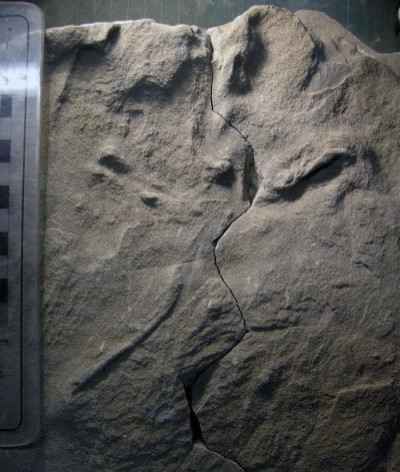Australia’s Oldest Bird Footprints Discovered, Tracks Were Formed 100 Million Years Ago [PHOTOS]

A recent discovery in Australia proves that there were birds living alongside other kinds of dinosaurs on the continent 100 million years ago. Australia’s oldest bird footprints, from the Early Cretaceous period, were found in a slab of rock recovered from the cliffs of Dinosaur Cove, a fossil-rich area on the coast of southern Victoria near Melbourne. The finding of the ancient bird tracks helps paleontologists better understand Australia’s prehistoric timeline.
"These tracks are evidence that we had sizable, flying birds living alongside other kinds of dinosaurs on these polar, river floodplains, about 105 million years ago," Anthony Martin, a paleontologist at Emory University in Atlanta, said in a statement. “The picture of early bird evolution in the Southern Hemisphere is mostly incomplete … but with these tracks, it just got a little better."
The latest fossilized tracks found at Dinosaur Cove were discovered by volunteers working at the site. Martin and his colleagues later analyzed the prehistoric prints, and determined them to be Australia’s earliest bird tracks.
The researchers noted a long drag mark made by a rear toe leading up to one of the bird’s footprints, indicating the imprints had been left by a creature that could fly. "I immediately knew what it was -- a flight landing track -- because I've seen many similar tracks made by egrets and herons on the sandy beaches of Georgia," Martin said. The birds that left the prehistoric footprints were roughly the size of a great egret or a small heron, according to Discovery News.
The markings probably occurred when the birds set down on the moist sand of an ancient river bank, whose waters formed the rocky coastal strata observed at Dinosaur Cove today. A great rift valley formed there as Australia separated from Antarctica 104 million years ago, when both made up a supercontinent called Gondwana.
As Environmental News Network noted, fossils of prehistoric landing tracks are rare, and could help scientists better understand the evolution of flight. Modern birds actually evolved from dinosaurs, and share many characteristics with the prehistoric reptiles, like nesting and burrowing.
"In some dinosaur lineages, that rear toe got longer instead of shorter and made a great adaptation for perching up in trees," Martin explained in a statement. "Tracks and other trace fossils offer clues to how non-avian dinosaurs and birds evolved and started occupying different ecological niches."
The footprints were discovered next to another footprint, that of a non-avian theropod, the group of dinosaurs closely related to birds that includes the infamous T-rex. According to Live Science, all three of the footprints were found in just one square foot of sandstone.
The Cretaceous period, from 145 million to 66 million years ago, was a geologic period when the Earth’s climate was relatively warm and the Earth was dotted by shallow inland seas. The Cretaceous ended with a large mass extinction, thought to be triggered by a massive comet, where three-quarters of plant and animal species on Earth died off.
Analysis of Australia’s oldest bird footprints will be published in the journal Pelaeontology. The discovery adds to a growing body of research that sheds light on prehistoric bird species and their evolution from dinosaurs.
In June, scientists discovered the oldest bird fossil ever in China. The 160 million-year-old fossil, called Aurornis, meaning “dawn bird,” was recovered from the well-known fossil beds of Liaoning Province.
According to the BBC, Aurornis measured roughly 20 inches from tail to beak and had very primitive skeletal features that make it one of the first avian dinosaurs.
© Copyright IBTimes 2024. All rights reserved.






















